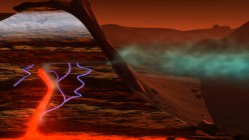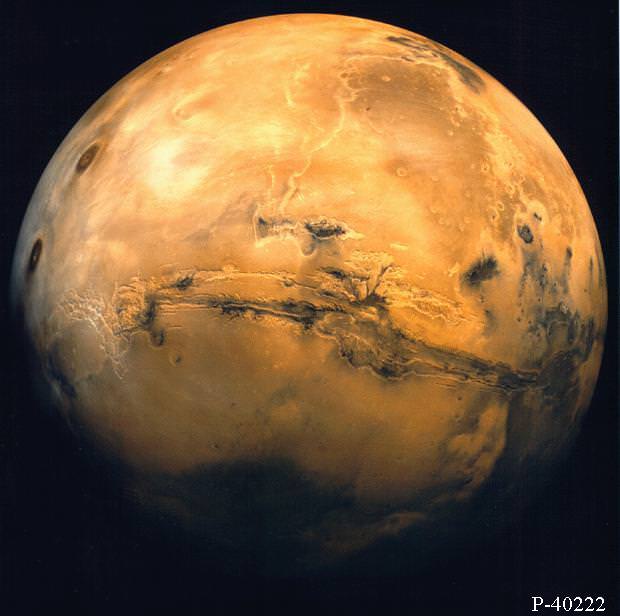[/caption]
A new paper that will be published Wednesday rules out the possibility that methane is delivered to Mars by meteorites, boosting the idea that the short-lived gas perhaps could be generated by either life or water, or maybe even both. Microorganisms living in the Martian soil could be producing methane gas as a by-product of their metabolic processes, or methane might be created as a result of reactions between volcanic rock and water. Either way, the prospect is exciting.
Methane on Mars was first detected in 1999, again in 2001 and 2003, which was widely reported, but not much was known about the origin or amount of the gas on Mars.
In January 2009, scientists analyzing data from telescopic observations and unmanned space missions announced that the methane on Mars is being constantly replenished by an unknown source and they are keen to uncover how the levels of methane are being topped up.

Methane has a short lifetime of just a few hundred years on Mars because it is constantly being depleted by a chemical reaction in the planet’s atmosphere, caused by sunlight.
Some researchers proposed meteorites might be responsible for Martian methane levels because when the rocks enter the planet’s atmosphere they are subjected to intense heat, causing a chemical reaction that releases methane and other gases into the atmosphere.
However, the new study, by researchers from Imperial College London, shows that the volumes of methane that could be released by the meteorites entering Mars’s atmosphere are too low to maintain the current atmospheric levels of methane. Previous studies have also ruled out the possibility that the methane is delivered through volcanic activity.
“Our experiments are helping to solve the mystery of methane on Mars,” said Dr. Richard Court, co-author of the study. “Meteorites vaporizing in the atmosphere are a proposed methane source but when we recreate their fiery entry in the laboratory we get only small amounts of the gas. For Mars, meteorites fail the methane test.”
The team used a technique called Quantitive Pyrolysis-Fourier Transform Infrared Spectroscopy to reproduce the same searing conditions experienced by meteorites as they enter the Martian atmosphere. The team heated the meteorite fragments to 1000 degrees Celsius and measured the gases that were released using an infrared beam.

When quantities of gas released by the laboratory experiments were combined with published calculations of meteorite in-fall rates on Mars, the scientists calculated that only 10 kilograms of meteorite methane was produced each year, far below the 100 to 300 tons required to replenish methane levels in the Martian atmosphere.
The researchers say their study will help NASA and ESA scientists who are planning a joint mission to the red planet in 2018 to search for the source of methane. The researchers say now that they have discovered that meteorites are not a source of Methane on Mars, ESA and NASA scientists can focus their attention on the two last remaining options.
“This work is a big step forward,” said co-author Mark Sephton. “As Sherlock Holmes said, eliminate all other factors and the one that remains must be the truth. The list of possible sources of methane gas is getting smaller and excitingly, extraterrestrial life still remains an option. Ultimately the final test may have to be on Mars.”
This research will be published in the Earth and Planetary Science Letters.
Source: Imperial College


The meteorite found in Antarctica, the Allen Hills 84001 meteorite, has been re-examined with better/more modern equipment and has been shown to contain fossilized bacterium remains after all!
So there WAS life on Mars at one point in its long history. NOW, with this new evidence, it looks as though there still IS life on Mars!
Not a big surprise really… as we now know that extremophiles inhabit the Earth’s crust, I find it hard to doubt that we will eventually find life on the Moon as well as Mars! albeit microscopic and not HNO based…
So if the ‘Martian methane’ is not due to extraplanetary sources, we’re down to biological or geological origin (or a combo)? That sounds like progress to me.
Let’s hope that f it’s life, it’s not contamination from previous human missions to Mars. I’m completely ignorant of how well any Earth bacteria can even survive in the Martian environment.
Imagine the scenario:
Life on earth – life on mars – life in Europa.
3 “independent” ecosystem in one stellar system… can you imagine the rest of the galaxy? Not to mention the universe!
I wonder if we were to ever find life or evidence of past life on Mars how people would take it. As having evolved there itself or arrived there somehow from Earth?
My humble not-so-scientific opinion: It would not surprise me to find primitive life on Mars. It *would* surprise me to not at least find primitive life in Europa.
Great!
Unfortunately IMO the way to bet is still on geological processes. (Because Mars has been geologically active, and since methane production metabolisms were the last to appear on Earth.)
I would love for that to be wrong!
@ SuperKevin:
That depends on if it is possible to tie a phylogeny together or not, say by them using the same genetic code.
@ Aqua:
Refs please!
[I know that the AH-84001 group recently reexamined the magnetite crystals that may be putative fossil crystals from martian magnetosome analogs. And that they claim to have ruled out two competing geological origins.
But infuriatingly they don’t seem to have improved on their 2000 or so analysis of size distribution. It remains critical and exquisitely quantitative among their commendable broad list of 6 characteristics, akin to micro-fossil researchers methods AFAIU them.
AFAIU it remains a qualitative eye balling of “a normal distribution”. (From typical biological growth processes with a membrane compartment, as opposed to geological processes typically resulting in log-normal size distributions.)
Not a rigorous statistical test of the same. And you can attempt to fit many distributions to their estimate, including the null hypothesis log-normal one.
Would a conclusive test been so difficult, one wonder? Especially when the observations are otherwise so interesting!
Bummer.]
“Let’s hope that f it’s life, it’s not contamination from previous human missions to Mars. I’m completely ignorant of how well any Earth bacteria can even survive in the Martian environment.”
The earliest possible contamination would have been some failed Soviet landers from about 40 years ago. If Earth mirobes are responsible for the methane, they would have had to multiply and spread dramatically to be responsible for hundreds of tonnes of methane. Not being a biologist I don’t know for sure how many tonnes of bacteria it would take to produce that quantity of methane, but I guess it would be thousands and thousands of tonnes. Mars may be able to support life, but it is definitely not the kind of paradise that would let bacteria increase from a handful of stowaways to thousands of tonnes in just 40 years.
We need to get a robotic molecular biological lab bench on Mars. We need to do PCRs are a wide range of sample and then run blots to sequence genes if they exist. That would end the question about whether life exist on Mars. If any genes discovered there are sufficiently divergent from anything on Earth we might assume a separate evolution and maybe an independent origin.
LC
Torbjorn Larsson OM – Google: “New evidence for life in the Allan Hills 84001 meteorite” and take a look-see.
You will find that CURRENT analysis of the magnetic particles found in the supposed fossilized bacterium seem to point toward a biological origin. (Released Nov. 24)
Regardless.. its good to see an ongoing debate as to the validity of any claims such as this. I for one have been swayed over to the ‘believer’ side of the equation.
I’m still putting my money on a photochemical process until someone shows me that damn critters.
Not quite. As I said before, phylogeny is the issue, and it can start anywhere along the biochemical path from abiogenesis to today. IMHO, if we find critters with the roughly the same genetic code but different genes, people would still claim phylogeny. Possibly you could also use metabolism, if metabolism first (in that case) was the primary pathway.
@ Aqua:
Thank you!
That was exactly the research that I referenced. I haven’t had time to read it thoroughly, just browse it, but as I said I can’t find any more results than that they (claim to have) eliminated two possible geological pathways.
That doesn’t mean that “the magnetic particles found in the supposed fossilized bacterium seem to point toward a biological origin”. As I noted, they have still, after ~ 10 years (!), to test quantitatively the most important of the characteristics they (rightly, IMHO) propose to use to test for biological origin.
So, yes, the latest analysis moves their analysis towards a biological origin, but it doesn’t point there.
Again, why are they hesitating/unable to do a simple statistics test?
Kerta’s et al Geochimica (2000) paper is (behind a paywall) “Thomas-Keprta, K. L., Bazylinski, D. A., Kirschvink, J. L., Clemett, S. J., McKay, D. S., Wentworth, S. J., Vali, H., Gibson, E. K., Jr., & Romanek, C. S. (2000) Geochim. Cosmochim. Acta 64 , 4049-4081.pmid:11543573”.
On p 4066 you will find fig 12 c-d deconvolution for the size distributions of magnetites from ALH84001 and terrestrial MV-1 magnetotactic bacteria.
Note that the ALH84001 looks comfortably like a log-normal distribution while the MV-1 doesn’t, that the suggested log-normal distribution is an ‘suggestion for the eye to follow’ unmarked log-normal distributions purposely far from fit illustrations, and that the only “test” for distribution that these data are subjected to is the remark that “These length distributions are narrower than expected for log-normal. [Note on log-normals removed.]” That however is not clear to me from the figure alone.
To test for a certain statistical distribution is not too difficult. Here is a paper by Clauset et al that does this for power-law distributions, because people have a tendency to propose those from scaling behavior despite the fact that they can often be fitted with mere exponential distributions. The 2nd author, (IIRC statistical physicist) Cosma Shalisi, have described this problem thoroughly on his blog.
For 20 data sets where power laws have been suggested they can only find one convincing test. (In that other distributions doesn’t seem as convincing fits.) Similar problems occur for alternative distributions.
They note:
“The study of power laws spans many disciplines, including physics, biology, engineering, computer science, the earth sciences, economics, political science, sociology, and statistics. Unfortunately, well founded methods for analyzing power-law data have not yet taken root in all, or even most, of these areas and in many cases hypothesized distributions are not tested rigorously against the data. This naturally leaves open the possibility that apparent power-law behavior is, in some cases at least, the result of wishful thinking.
In this paper we have argued that the common practice of identifying and quantifying power-law distributions by the approximately straight-line behavior of a histogram on a doubly logarithmic plot should not be trusted: such straight-line behavior is a necessary but by no means sufficient condition for true power-law behavior. Instead we have presented a statistically principled set of techniques that allow for the validation and quantification of power laws. Properly applied, these techniques can provide objective evidence for or against the claim that a particular distribution follows a power law. In principle, they could also be extended to other, non-power-law distributions as well, although we have not given such an extension here. [My bold.]”
As I remarked before, how hard can it be?
Let me add two things:
– Note that Keprta et al doesn’t even make a fit over two-three orders of magnitude as the failed power-law hypotheses does. They just suggest, and the suggestion runs contrary to the actual plot.
If the “fit but not test” approach is called “wishful thinking” by Clauset et al, I would suggest the description “wishful wishful thinking” of Keprta et al handwaving on this exciting subject. :-/
– Also, and above all, there are no “supposed fossilized bacterium” found or even suggested by Keprta et al! The magnetites are (solely, I think) found within carbonates which are claimed to be of geological origin in the same paper that you seem to refer to.
This is the second time in a short while I’ve seen this “bacteria” find claim, but it is AFAIU a fabrication of magazines way back on the first results – because some imaged structures can be “pareidoliazed” as “bacteria” like.
Please let us discuss facts and not fabrications and/or fantasies on this science blog!
“some imaged structures” – some other imaged structures, to boot. It isn’t even the frakkin’ carbonates which has the magnetites that they look at when the imagine “bacterias”! Fantasies on top of fantasies.
My point about genes being sufficiently divergent is that they might not fit into a clade, or not very well. Clearly if the genome turns out to be 80% similar to some other clade of prokaryotes then we could give weight to the idea of life having been transported to Mars. Presumably this would be by material thrown into space by an asteroid impact. Conversely, if the genome is sufficiently different it might not fit into any clade of prokaryotes we know.
LC